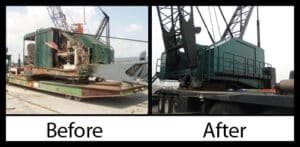

Cummins dealer Cummins Atlantic Inc., Columbia, S.C., provided the engines, and, working with WHECO, actually repowered the first crane in the project. WHECO performed all of the SLEPs, including the re-power on the second RTC 8040 of the Cranes Inc., machines. Rusty Ulmer of Cummins Atlantic says construction equipment owners in general are running their machines longer.
“People have increased the length of service of a machine,” he says. “Typically you would run a truck for five years or 500,000 miles, where now they’re running for seven years or 700,000 miles. We’re seeing more maintenance because they’re going to mileages we haven’t seen before. It has a lot to do with the economy.”
Weiss says other crane owners should crunch the numbers for themselves while work is slow and cranes are idle. “I think this is something more people should consider at the 10-year mark,” he says. “If you don’t have the money to replace a crane, this is a good thing to do. Hopefully by the time they’re ready to be retired, the economy is better and there’s trade-in value for them. It’s a good way to get through this slow period.” Ulmer, too, suggests crane owners do the math. “A $500,000 piece of equipment or a $25,000 engine…you can justify a new engine a lot easier than you can a whole crane,” he says. Many crane owners hesitate to invest in a re-power project, Ulmer says, simply because they just haven’t investigated the possibilities. “When WHECO called me about re-powering these cranes, they said [Weiss had] talked to half a dozen people who’d told him to just replace the crane. Nobody told him to replace the engine. And it’s not a really complicated job to do.”
Other crane owners avoid powering up because they’re fearful of going from a mechanical engine to electronic technology. “Once they get electronics in and see the capability of the engine and the things they can do from both an operator and management standpoint,” they get over their trepidation, Ulmer says. “They’re getting a cleaner-burning, more efficient engine in the electronics. And they can tie into the machine through computers and monitor the engine for fuel consumption, service hours, work load, or service intervals.”
For instance, Ulmer says that typically on a turbocharged engine, which most diesels are, at the end of the workday, the machine should idle for three to five minutes before the operator shuts it down. “A lot of operators will go do something else and come back to the machine much later,” he says. “With an electronic engine, you can program it to automatically shut down after, say, five to seven minutes.”
A screening machine
To run RTs on jobs in the Big Apple, Cranes Inc. is also required to have diesel particulate filters, or DPFs, on their cranes. The add-on component, similar to a catalytic converter, filters out diesel particles. “Even though you put a Tier 3 engine in a crane, New York City says the Tier 3 is not clean enough,” says Weiss. “You have to add a DPF on top of that to filter the reduced diesel emissions from the Tier 3. From what I understand, it’s a growing situation nationwide.”
And that, says Shiffler, creates frustration among crane owners, especially where rentals are concerned, because every state has different regulations. “That’s what makes it very difficult for a crane owner to rent outside of the state he’s in,” he says. “In New York, he has to know the standards for Massachusetts, New Jersey, wherever his business takes him. In California, crane companies have to know what’s expected in Arizona, Washington, and Oregon and vice versa.”
Since Bigge Crane and Rigging, San Leandro, Calif., can’t beat their state’s strict air emissions standards, it decided in January to join the bandwagon and create another service offering. The company became an active Cleaire retrofit emissions filter dealer and certified Cleaire filter installer for all on-road and off-road cranes. Sales and installations will be offered at every Bigge service facility in California, and a field service fleet of certified technicians will install and service filters anywhere in the United States.
“We run a very diverse fleet,” explains Daren Griffin, service manager, Bigge Corporate, who says the company has invested a lot of time in understanding how to comply with the CARB regs. “We were in a unique position to help other companies,” he says. “We felt Cleaire [also in San Leandro] offered the best product on the market, and that’s how we started partnering on their filters.”
Griffin says putting a new filter on an RT, truck crane, or crawler buys the owner an extra three to four years on the life of the crane. “Because Cleaire offers a wide variety of filters for cranes, we can offer something to everyone,” Griffin says. The installation process usually takes about three days, on most cranes.
Depending on the size of the fleet, California has set a timetable in which crane owners will have to comply with the new diesel engine Tier 3 and later Tier 4 requirements. At press time there had been no immediate need for crane owners to have them installed because CARB enforcement was on hold.
“They were anticipating the deadline for large fleets to be March 1st, 2010,” says Griffin. “While the deadline remains unclear, everybody thinks it’ll be based on the economy. When the economy rebounds, we can look for it to gain traction again.”





